Blog - Foot Doctor, Chambersburg and McConnellsburg, PA
Stages of an Achilles Tendon Injury
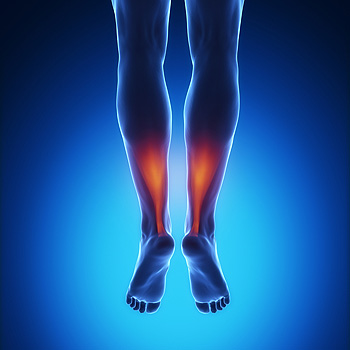 If you experience pain and discomfort in the back of your calf, you may have injured your Achilles tendon. This can happen as a result of wearing improper footwear, running on varied surfaces, or performing explosive movements that consist of jumping and pushing off of your feet. Some of the symptoms that are associated with this include increased stiffness, soreness, and difficulty walking. Forms of this type of injury include an Achilles tendon rupture, which is also known as a tear, and Achilles tendonitis, which occurs as a result of inflammation. There are typically different stages in Achilles tendon injuries. The first stage is often represented by discomfort that is felt after sleeping. Severe pain is indicative of the second and third stages, and it often affects any type of running that is performed. The last stage occurs when the pain becomes unmanageable, and accomplishing daily activities is difficult. If you have injured your Achilles tendon, it is suggested that you consult with a podiatrist who can guide you toward proper treatment.
If you experience pain and discomfort in the back of your calf, you may have injured your Achilles tendon. This can happen as a result of wearing improper footwear, running on varied surfaces, or performing explosive movements that consist of jumping and pushing off of your feet. Some of the symptoms that are associated with this include increased stiffness, soreness, and difficulty walking. Forms of this type of injury include an Achilles tendon rupture, which is also known as a tear, and Achilles tendonitis, which occurs as a result of inflammation. There are typically different stages in Achilles tendon injuries. The first stage is often represented by discomfort that is felt after sleeping. Severe pain is indicative of the second and third stages, and it often affects any type of running that is performed. The last stage occurs when the pain becomes unmanageable, and accomplishing daily activities is difficult. If you have injured your Achilles tendon, it is suggested that you consult with a podiatrist who can guide you toward proper treatment.
Achilles tendon injuries need immediate attention to avoid future complications. If you have any concerns, contact Dr. Steven Schwartz of Pennsylvania. Our doctor can provide the care you need to keep you pain-free and on your feet.
What Is the Achilles Tendon?
The Achilles tendon is a tendon that connects the lower leg muscles and calf to the heel of the foot. It is the strongest tendon in the human body and is essential for making movement possible. Because this tendon is such an integral part of the body, any injuries to it can create immense difficulties and should immediately be presented to a doctor.
What Are the Symptoms of an Achilles Tendon Injury?
There are various types of injuries that can affect the Achilles tendon. The two most common injuries are Achilles tendinitis and ruptures of the tendon.
Achilles Tendinitis Symptoms
- Inflammation
- Dull to severe pain
- Increased blood flow to the tendon
- Thickening of the tendon
Rupture Symptoms
- Extreme pain and swelling in the foot
- Total immobility
Treatment and Prevention
Achilles tendon injuries are diagnosed by a thorough physical evaluation, which can include an MRI. Treatment involves rest, physical therapy, and in some cases, surgery. However, various preventative measures can be taken to avoid these injuries, such as:
- Thorough stretching of the tendon before and after exercise
- Strengthening exercises like calf raises, squats, leg curls, leg extensions, leg raises, lunges, and leg presses
If you have any questions please feel free to contact our offices located in Chambersburg, and Mcconnellsburg, PA . We offer the newest diagnostic tools and technology to treat your foot and ankle needs.
Different Treatments and Recovery Times for Broken Ankles
The treatment and recovery for a broken ankle depends on the doctor’s specific diagnosis. For a stable ankle break, you may need to use crutches in order to keep weight off of the injury. You also may need to wear a boot or a cast. An unstable break, on the other hand, will typically require surgery. Both those with stable and unstable ankle breaks usually need to attend physical therapy. The recovery varies on the injury and the surgery. The time to return to low-impact athletic activity can span from three to four months for a stable ankle break, and nine months to one year for unstable ankle breaks. Be sure to consult with a podiatrist on the particular details of your ankle injury.
Broken ankles need immediate treatment. If you are seeking treatment, contact Dr. Steven Schwartz from Pennsylvania. Our doctor can provide the care you need to keep you pain-free and on your feet.
Broken Ankles
A broken ankle is experienced when a person fractures their tibia or fibula in the lower leg and ankle area. Both of these bones are attached at the bottom of the leg and combine to form what we know to be our ankle.
When a physician is referring to a break of the ankle, he or she is usually referring to a break in the area where the tibia and fibula are joined to create our ankle joint. Ankles are more prone to fractures because the ankle is an area that suffers a lot of pressure and stress. There are some obvious signs when a person experiences a fractured ankle, and the following symptoms may be present.
Symptoms of a Fractured Ankle
- Excessive pain when the area is touched or when any pressure is placed on the ankle
- Swelling around the area
- Bruising of the area
- Area appears to be deformed
If you suspect an ankle fracture, it is recommended to seek treatment as soon as possible. The sooner you have your podiatrist diagnose the fracture, the quicker you’ll be on the way towards recovery.
If you have any questions, please feel free to contact our offices located in Chambersburg, and Mcconnellsburg, PA . We offer the newest diagnostic and treatment technologies for all your foot care needs.
Healing Time Frame for Stress Fractures
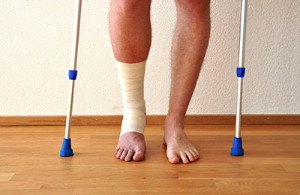 Stress fractures are tiny cracks in the bones of the feet. They occur as a result of participating in activities that cause the bones in the foot to weaken and crack faster than the healing process can begin. This can occur due to several reasons, including training in your chosen sport before adequate healing has been completed, increasing the amount of time training in a short period of time, or running on different surfaces. The symptoms that are associated with stress fractures often include swelling, burning pain, and difficulty walking on the affected foot. Effective treatment begins with staying off the foot for several weeks, depending on the severity of the injury. This can be accomplished by wearing a cast. If you have sustained a stress fracture, speak to a podiatrist who can guide you toward proper treatment options.
Stress fractures are tiny cracks in the bones of the feet. They occur as a result of participating in activities that cause the bones in the foot to weaken and crack faster than the healing process can begin. This can occur due to several reasons, including training in your chosen sport before adequate healing has been completed, increasing the amount of time training in a short period of time, or running on different surfaces. The symptoms that are associated with stress fractures often include swelling, burning pain, and difficulty walking on the affected foot. Effective treatment begins with staying off the foot for several weeks, depending on the severity of the injury. This can be accomplished by wearing a cast. If you have sustained a stress fracture, speak to a podiatrist who can guide you toward proper treatment options.
Activities where too much pressure is put on the feet can cause stress fractures. To learn more, contact Dr. Steven Schwartz from Pennsylvania. Our doctor can provide the care you need to keep your pain free and on your feet.
Dealing with Stress Fractures of the Foot and Ankle
Stress fractures occur in the foot and ankle when muscles in these areas weaken from too much or too little use. The feet and ankles then lose support when walking or running from the impact of the ground. Since there is no protection, the bones receive the full impact of each step. Stress on the feet can cause cracks to form in the bones, thus creating stress fractures.
What Are Stress Fractures?
Stress fractures occur frequently in individuals whose daily activities cause great impact on the feet and ankles. Stress factors are most common among:
- Runners
- People affected with Osteoporosis
- Tennis or basketball players
- Gymnasts
- High impact workouts
Symptoms
Pain from the fractures occur in the area of the fractures and can be constant or intermittent. It will often cause sharp or dull pain with swelling and tenderness. Engaging in any kind of activity which involves high impact will aggravate pain.
If you have any questions please feel free to contact our offices located in Chambersburg, and Mcconnellsburg, PA . We offer the newest diagnostic and treatment technologies for all your foot and ankle needs.
Facts About Toenail Fungus
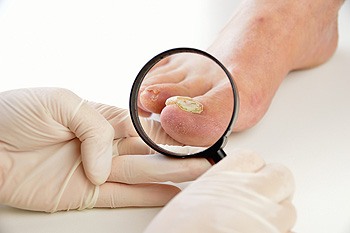 The purpose of the toenail is to protect the toes against injury. Many patients experience toenail fungus at some point in their lives. They often notice the nail will change consistency and has a yellow or white tinge to it. Additionally, the nail will become darker and thicker as the fungus grows deeper into the nail bed. This condition is considered to be contagious, and the fungus that causes this thrives in warm and moist areas. These include public pools and surrounding areas, shower room floors, and locker rooms. As the fungus progresses, the nail may become brittle, and may have a foul odor to it. It may be possible to prevent this type of fungus from entering the body. This can be accomplished by wearing appropriate shoes while in public areas, and changing your socks often if they are wet for the majority of the day. Please consult with a podiatrist for additional information about toenail fungus.
The purpose of the toenail is to protect the toes against injury. Many patients experience toenail fungus at some point in their lives. They often notice the nail will change consistency and has a yellow or white tinge to it. Additionally, the nail will become darker and thicker as the fungus grows deeper into the nail bed. This condition is considered to be contagious, and the fungus that causes this thrives in warm and moist areas. These include public pools and surrounding areas, shower room floors, and locker rooms. As the fungus progresses, the nail may become brittle, and may have a foul odor to it. It may be possible to prevent this type of fungus from entering the body. This can be accomplished by wearing appropriate shoes while in public areas, and changing your socks often if they are wet for the majority of the day. Please consult with a podiatrist for additional information about toenail fungus.
For more information about treatment, contact Dr. Steven Schwartz of Pennsylvania. Our doctor can provide the care you need to keep you pain-free and on your feet.
Toenail Fungus Treatment
Toenail fungus is a condition that affects many people and can be especially hard to get rid of. Fortunately, there are several methods to go about treating and avoiding it.
Antifungals & Deterrence
Oral antifungal medicine has been shown to be effective in many cases. It is important to consult with a podiatrist to determine the proper regiment for you, or potentially explore other options.
Applying foot powder on the feet and shoes helps keep the feet free of moisture and sweat.
Sandals or open toed shoes – Wearing these will allow air movement and help keep feet dry. They also expose your feet to light, which fungus cannot tolerate. Socks with moisture wicking material also help as well.
If you have any questions please feel free to contact our offices located in Chambersburg, and Mcconnellsburg, PA . We offer the newest diagnostic tools and technology to treat your foot and ankle needs.
Children and Ingrown Toenails
 If your child complains of pain on the side of the big toe, it may be indicative of an ingrown toenail. Additional symptoms include swelling and redness in the corner of the affected toe, difficulty in walking, and possible drainage. This condition typically develops as a result of toenails that are trimmed incorrectly, or from wearing shoes that do not fit properly. Mild relief can be obtained from soaking the affected nail in warm water, which may help to soften the nail. If the symptoms become severe, it is advised to speak to a podiatrist as quickly as possible, so proper treatment can begin.
If your child complains of pain on the side of the big toe, it may be indicative of an ingrown toenail. Additional symptoms include swelling and redness in the corner of the affected toe, difficulty in walking, and possible drainage. This condition typically develops as a result of toenails that are trimmed incorrectly, or from wearing shoes that do not fit properly. Mild relief can be obtained from soaking the affected nail in warm water, which may help to soften the nail. If the symptoms become severe, it is advised to speak to a podiatrist as quickly as possible, so proper treatment can begin.
Ingrown toenails may initially present themselves as a minor discomfort, but they may progress into an infection in the skin without proper treatment. For more information about ingrown toenails, contact Dr. Steven Schwartz of Pennsylvania. Our doctor can provide the care you need to keep you pain-free and on your feet.
Ingrown Toenails
Ingrown toenails are caused when the corner or side of a toenail grows into the soft flesh surrounding it. They often result in redness, swelling, pain, and in some cases, infection. This condition typically affects the big toe and may recur if it is not treated properly.
Causes
- Improper toenail trimming
- Genetics
- Improper shoe fitting
- Injury from pedicures or nail picking
- Abnormal gait
- Poor hygiene
You are more likely to develop an ingrown toenail if you are obese, have diabetes, arthritis, or have any fungal infection in your nails. Additionally, people who have foot or toe deformities are at a higher risk of developing an ingrown toenail.
Symptoms
Some symptoms of ingrown toenails are redness, swelling, and pain. In rare cases, there may be a yellowish drainage coming from the nail.
Treatment
Ignoring an ingrown toenail can have serious complications. Infections of the nail border can progress to a deeper soft-tissue infection, which can then turn into a bone infection. You should always speak with your podiatrist if you suspect you have an ingrown toenail, especially if you have diabetes or poor circulation.
If you have any questions, please feel free to contact our offices located in Chambersburg, and Mcconnellsburg, PA . We offer the newest diagnostic and treatment technologies for all your foot care needs.
Children’s First Shoes
When walking first begins, many children walk with their feet apart, and this is beneficial in maintaining balance. The gap between the feet will gradually close as the walking process is perfected. Additional common foot conditions include flat feet, or you may notice your three year old is walking on tiptoes. Research has indicated the importance of walking barefoot while indoors, and this helps to strengthen the muscles in the feet. When the first shoes are purchased, it is helpful to choose shoes that have laces or buckles. This helps the foot to fit securely in the shoe. Additionally, the toenails must be trimmed correctly, and this is necessary in possibly preventing ingrown toenails from occurring. If you have any questions about the development of your child’s feet, it is suggested to speak to a podiatrist who can properly assist you.
Making sure that your children maintain good foot health is very important as they grow. If you have any questions, contact Dr. Steven Schwartz of Pennsylvania. Our doctor can provide the care you need to keep you pain-free and on your feet.
Keeping Children's Feet Healthy
Having healthy feet during childhood can help prevent medical problems later in life, namely in the back and legs. As children grow, their feet require different types of care. Here are some things to consider...
Although babies do not walk yet, it is still very important to take care of their feet.
Avoid putting tight shoes or socks on his or her feet.
Allow the baby to stretch and kick his or her feet to feel comfortable.
As a toddler, kids are now on the move and begin to develop differently. At this age, toddlers are getting a feel for walking, so don’t be alarmed if your toddler is unsteady or ‘walks funny’.
As your child gets older, it is important to teach them how to take care of their feet.
Show them proper hygiene to prevent infections such as fungus.
Be watchful for any pain or injury.
Have all injuries checked by a doctor as soon as possible.
Comfortable, protective shoes should always be worn, especially at play.
If you have any questions please feel free to contact our offices located in Chambersburg, and Mcconnellsburg, PA . We offer the newest diagnostic and treatment technologies for all your foot and ankle needs.
Types of Foot Pain
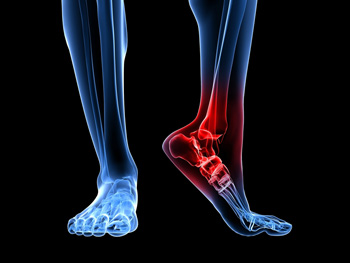 Many people experience heel pain at some point in their lives. Research has indicated that the most common form of heel pain is known as plantar fasciitis. This condition develops when the tendon that connects the heel to the toes becomes inflamed and irritated. Possible causes for this may be flat feet or if the arch is exceptionally high. Sever’s disease is a foot condition that may be experienced by teenagers who frequently participate in sporting activities. When this occurs, trauma is inflicted in the growth plate of the heel bone and may result in pain and discomfort. The Achilles tendon connects the heel bone to the calf muscles, and if this should become torn, pain is generally felt in the heel of the foot. If you are experiencing any type of foot pain, it is strongly suggested that you consult with a podiatrist who can properly diagnosis and treat your foot condition.
Many people experience heel pain at some point in their lives. Research has indicated that the most common form of heel pain is known as plantar fasciitis. This condition develops when the tendon that connects the heel to the toes becomes inflamed and irritated. Possible causes for this may be flat feet or if the arch is exceptionally high. Sever’s disease is a foot condition that may be experienced by teenagers who frequently participate in sporting activities. When this occurs, trauma is inflicted in the growth plate of the heel bone and may result in pain and discomfort. The Achilles tendon connects the heel bone to the calf muscles, and if this should become torn, pain is generally felt in the heel of the foot. If you are experiencing any type of foot pain, it is strongly suggested that you consult with a podiatrist who can properly diagnosis and treat your foot condition.
Many people suffer from bouts of heel pain. For more information, contact Dr. Steven Schwartz of Pennsylvania. Our doctor can provide the care you need to keep you pain-free and on your feet.
Causes of Heel Pain
Heel pain is often associated with plantar fasciitis. The plantar fascia is a band of tissues that extends along the bottom of the foot. A rip or tear in this ligament can cause inflammation of the tissue.
Achilles tendonitis is another cause of heel pain. Inflammation of the Achilles tendon will cause pain from fractures and muscle tearing. Lack of flexibility is also another symptom.
Heel spurs are another cause of pain. When the tissues of the plantar fascia undergo a great deal of stress, it can lead to ligament separation from the heel bone, causing heel spurs.
Why Might Heel Pain Occur?
- Wearing ill-fitting shoes
- Wearing non-supportive shoes
- Weight change
- Excessive running
Treatments
Heel pain should be treated as soon as possible for immediate results. Keeping your feet in a stress-free environment will help. If you suffer from Achilles tendonitis or plantar fasciitis, applying ice will reduce the swelling. Stretching before an exercise like running will help the muscles. Using all these tips will help make heel pain a condition of the past.
If you have any questions please contact our offices located in Chambersburg, and Mcconnellsburg, PA . We offer the newest diagnostic and treatment technologies for all your foot and ankle needs.
What It Means to Have Flat Feet
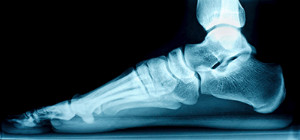 Flat feet are usually harmless and can affect people of all ages. Flat feet are generally associated with overpronation of the foot, which means that the arch descends downward. Fallen arches in adults are typically permanent and non-reversible, but flat feet in children can oftentimes be resolved. Most people with flat feet don’t experience symptoms. However, there are possible symptoms that include midfoot, hip, knee, and lower back pain as a result of the change in gait from having fallen arches. This pain can usually be alleviated with over the counter pain medications, but in more severe cases a doctor might recommend further measures to be taken. Orthotic arch supports and foot gymnastics are two methods for reducing pain associated with flat feet. If you have flat feet and are concerned, then it is suggested you speak a podiatrist to receive more information.
Flat feet are usually harmless and can affect people of all ages. Flat feet are generally associated with overpronation of the foot, which means that the arch descends downward. Fallen arches in adults are typically permanent and non-reversible, but flat feet in children can oftentimes be resolved. Most people with flat feet don’t experience symptoms. However, there are possible symptoms that include midfoot, hip, knee, and lower back pain as a result of the change in gait from having fallen arches. This pain can usually be alleviated with over the counter pain medications, but in more severe cases a doctor might recommend further measures to be taken. Orthotic arch supports and foot gymnastics are two methods for reducing pain associated with flat feet. If you have flat feet and are concerned, then it is suggested you speak a podiatrist to receive more information.
Flatfoot is a condition many people suffer from. If you have flat feet, contact Dr. Steven Schwartz from Pennsylvania. Our doctor will treat your foot and ankle needs.
What Are Flat Feet?
Flatfoot is a condition in which the arch of the foot is depressed and the sole of the foot is almost completely in contact with the ground. About 20-30% of the population generally has flat feet because their arches never formed during growth.
Conditions & Problems:
Having flat feet makes it difficult to run or walk because of the stress placed on the ankles.
Alignment – The general alignment of your legs can be disrupted, because the ankles move inward which can cause major discomfort.
Knees – If you have complications with your knees, flat feet can be a contributor to arthritis in that area.
Symptoms
- Pain around the heel or arch area
- Trouble standing on the tip toe
- Swelling around the inside of the ankle
- Flat look to one or both feet
- Having your shoes feel uneven when worn
Treatment
If you are experiencing pain and stress on the foot you may weaken the posterior tibial tendon, which runs around the inside of the ankle.
If you have any questions please feel free to contact our offices located in Chambersburg, and Mcconnellsburg, PA . We offer the newest diagnostic and treatment technologies for all your foot and ankle needs.




